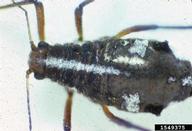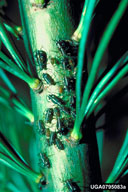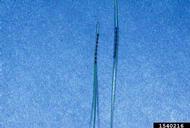White pine aphid
Cinara strobi (Fitch) (Hemiptera Aphidae)
Orientation to pest
White pine aphid, Cinara strobi (Fitch), is a native insect in North America that feeds on white pine (Pinus strobus L.). It is easily recognized by its large size (3-4 mm), slightly dull metallic grey color with a white stripe on middle of the thorax and spots of white wax on each side of the abdomen. Eggs are laid in the fall, end-to-end along the needle and hatch in the spring. White pine aphid feeds on branches and upper trunks. Because it forms large colonies and is large, it produces copious amounts of honeydew. It is usually attended by ants. Other than the honeydew being a nuisance and fostering sooty mold, direct damage to the tree itself is rare; but occasionally dense aphid populations damage young pines or individual branches of large trees.
Hosts commonly attacked
This aphid is only found on white pine (P. strobus).
Distribution in the USA
White pine aphid is found in the United States from New England to the Great Lakes states, south to the Carolinas in association with eastern white pine.
Images of white pine aphid
| Figure 1. Close view of white pine aphid, Cinara strobi | Figure 2. Colony of white pine aphid | Figure 3. Eggs of white pine aphid on pine needle |
Important biological control agents related to this pest species
The braconids Pauesia bicolor (Ashmead) and Pausia xanthothera (Smith) are known as parasitoids of this and other aphids in the genus Cinara.






